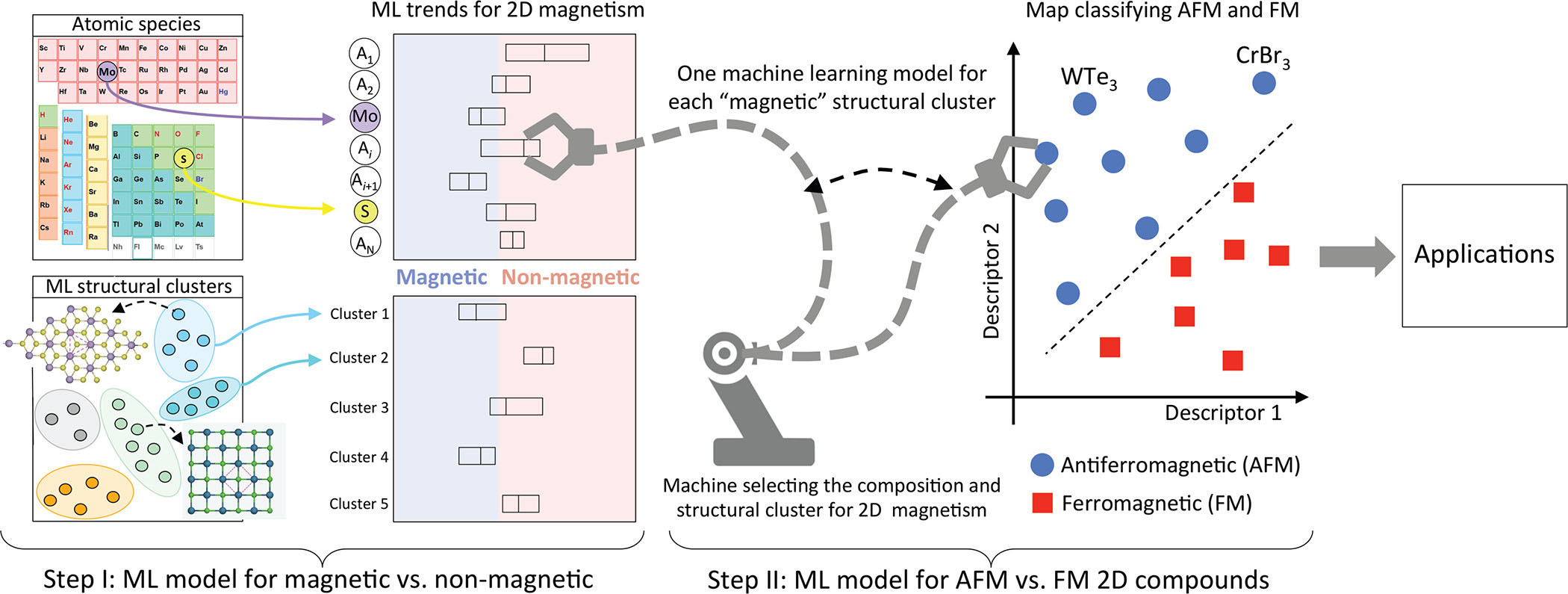| Feb 21, 2022 |
A data-driven strategy to explore the magnetism in 2D materials
(Nanowerk News) The discovery of 2D magnetism has not only opened a new path for potential revolutionary spintronic and valleytronic applications but also raised fundamental questions about the understanding and prediction of ferromagnetic and antiferromagnetic ordering in 2D compounds.
|
|
The description of magnetic ordering in 2D materials is complex. More than 50 years ago, based on the isotropic Heisenberg model, Mermin and Wagner demonstrated that, unlike bulk compounds, in 2D materials long-range magnetic order is suppressed by thermal fluctuations.
|
|
This suggests that 2D materials can only exhibit magnetic order in the presence of large magneto-crystalline anisotropy, and hence, the magnetism in 2D and bulk materials is supposed to have different physical mechanisms.
|
|
In recent years, much effort has been invested in the systematic prediction of magnetic two-dimensional systems, coming mainly from density functional theory (DFT) calculations. These predictions are based on a direct approach that involves the calculation of all possible candidates. However, these trial-and-error processes can be time-consuming and expensive.
|
|
In a recent paper in ACS Applied Materials & Interfaces ("Machine Learning Study of the Magnetic Ordering in 2D Materials"), researchers propose a data-driven strategy to explore the magnetism in 2D materials: contrary to the commonly employed direct approach, they aim to explore the material-to-attribute connection to provide the simplest correlation between magnetic ordering and features, for example, composition, crystal symmetry, and atomic properties.
|
 |
| Illustration of the proposed machine learning strategy to determine and predict the existence of magnetism (step I) in a given 2D compound and its specific magnetic ordering (step II). The starting point for this strategy is the clustering of atomic species and structures. Atomic species are intrinsically clustered according to the organization of the periodic table, while a ML model is performed to group structures according to the possible composition, crystal point group, and local distortions. This cluster is then used to identify the tendency of a specific element and structure to form a magnetic (blue) or nonmagnetic (red) 2D structure. If the specific combination of atoms and structures for the 2D compound tends to be magnetic, we identify its position in a materials map separating antiferromagnetic from ferromagnetic ordering. These positions are computed by means of atomic features of the constituent atoms. Finally, this ML strategy allows us to predict and select compounds for specific applications in electronics and spintronics. (Reprinted with permission by American Chemical Society) (click on image to enlarge)
|
|
Specifically, the authors train machine learning algorithms using a database of 2D magnetic materials to obtain descriptors that are capable of classifying materials as nonmagnetic, ferromagnetic, or antiferromagnetic.
|
|
Their strategy is divided into two main steps, namely, 1) to first develop a random forest model to separate magnetic compounds from nonmagnetic ones based on trends in the crystal structure and atomic composition, and 2) on the basis of the sure independence screening and sparsifying operator (SISSO) method, to find a mathematical model (i.e., a function of the atomic features) that uses the composition to provide a materials map with defined regions for ferromagnetic and antiferromagnetic 2D materials.
|
|
The researchers note that the random forest algorithm used in their work was able to successfully differentiate magnetic from nonmagnetic compounds with great accuracy. Nonmagnetic compounds were predicted with an accuracy of ∼96%, while for magnetic compounds this accuracy was ∼85%.
|
|
In conclusion, the authors write that their findings can be useful in the search for novel 2D magnetic materials, expanding the possibilities of this expanding and exciting area to compounds that can be more stable and easy to synthesize than the candidates observed so far.
|

 By
Michael
Berger
– Michael is author of three books by the Royal Society of Chemistry:
Nano-Society: Pushing the Boundaries of Technology,
Nanotechnology: The Future is Tiny, and
Nanoengineering: The Skills and Tools Making Technology Invisible
Copyright ©
Nanowerk LLC
By
Michael
Berger
– Michael is author of three books by the Royal Society of Chemistry:
Nano-Society: Pushing the Boundaries of Technology,
Nanotechnology: The Future is Tiny, and
Nanoengineering: The Skills and Tools Making Technology Invisible
Copyright ©
Nanowerk LLC
